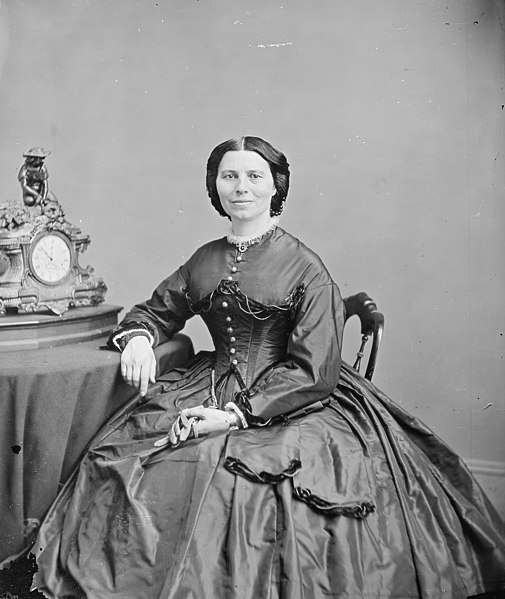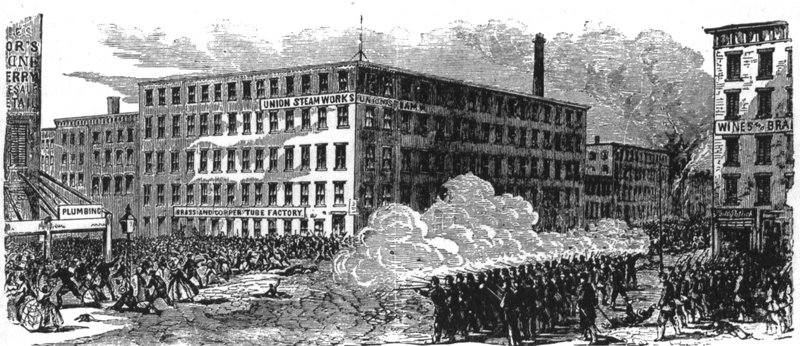
With the Civil War in full effect, the North was experiencing a boom in wartime production and huge economic growth. The rich were getting richer, but unfortunately, they did not pass along the wealth. The poor were still working in factories for meager wages.
Northern women were feeling the effects of the war, and their roles were changing. More job opportunities were opening up for them as men were being conscripted, or drafted, to fight in the war. Besides fulfilling traditional men's jobs on the homefront, women were also involved in the war effort. In particular, many took on the responsibility of helping wounded soldiers.
Read the following information about the Northern homefront and take notes.

Clara Barton
For the most part, Northerners saw the war from a distance, since most of the battles took place in the South. News from the battlefront and letters home from the soldiers kept the war in people’s minds. Almost every woman who stayed at home was touched in some way by the war. Many Northern and Southern women took on new responsibilities during the war. They became teachers, office workers, salesclerks, and government workers. They worked in factories and managed farms. They also suffered the loss of husbands, fathers, sons, and brothers. Women performed many jobs that helped the soldiers and the armies. They rolled bandages, wove blankets, and made ammunition. Many women collected food, clothing, and medicine to distribute to the troops. They also raised money for supplies.
In the Civil War, for the first time, thousands of women served as nurses. At first, many doctors did not want women nurses on the grounds that women were too delicate for such work. Men also disapproved of women doing what was considered male work, and felt it was improper for women to tend the bodies of unknown men. Strong-minded women disregarded these objections. In the North, Dorothea Dix organized large numbers of women to serve as military nurses. Another Northerner, Clara Barton, became famous for her work with wounded soldiers. Based on her experiences, she went on to create the Red Cross, an international organization that helps victims of disaster and war even today.

An illustration depicting the draft riots in New York City in July 1863
The war efforts of the Union faced opposition. Politicians objected to wartime policies, and ordinary citizens protested the way the war affected their lives. When the war began, Northern Democrats split into two groups. One group supported most of Lincoln’s wartime policies. The other, the “Peace Democrats,” favored negotiating with the Confederacy. The Peace Democrats warned that continuing the war would lead to “terrible social change and revolution.” They also appealed to racist feelings among Northern whites. Republican newspapers called the Peace Democrats “Copperheads.” When Union armies fared poorly, support for the Copperheads rose. Some Republicans suspected Copperheads of aiding the Confederates. The president ordered the arrest of anyone interfering with the war effort, such as discouraging men from enlisting in the army. Several times Lincoln suspended the writ of habeas corpus, which guarantees accused individuals the right to a hearing before being jailed.
In the middle of 1862, Lincoln called for 300,000 volunteer soldiers. Each state was given a quota, and if it could not meet the quota, it had no recourse but to draft men into the state militia. Union states encouraged enlistment by offering bounties, or payments to encourage volunteers. In March 1863, when this system failed, the North turned to a draft. All men from age 20 to 45 had to register, and the army drew the soldiers it needed from this pool of names. A person could avoid the draft by hiring a substitute or by paying the government $300. Draft laws aroused opposition, with protests erupting into riots in several Northern cities. The worst disturbance took place in New York City in July 1863. Angry mobs, opposed to the draft and to fighting to free African Americans, went on a rampage of burning, looting, and killing. After four days of terror, more than 100 people were dead. Troops from the Army of the Potomac had to be rushed in to end the rioting.

Artwork showing a factory on a river in Pennsylvania
The Civil War strained the Northern economy, but with greater resources, was better able to cope with wartime demands than the South was. Both the Union and the Confederacy financed the war by borrowing money, increasing taxes, and printing paper money. The North borrowed more than $2 billion, mainly by selling war bonds that promised high interest. Both sides imposed new taxes as well. The Union passed an income tax in 1861.
During the war, prices rose faster than wages in the North. This inflation, a general increase in prices, caused great hardship for working people. Overall, however, the Northern economy boomed. The need for a steady supply of food for Union troops helped farmers prosper. Factory production grew as manufacturers responded to the demands of war. The army needed many items, from guns and ammunition to shoes and uniforms. Greater use of machinery and the standardization of parts made it possible for the North to produce what it needed. During the war, coal and iron production reached their highest levels. Traffic on the railroads and the Erie Canal rose over 50%. Union manufacturers grew profitable.
| What was the North manufacturing? | coal and iron for ships and railroads |
| Who was responsible for forming the American Red Cross? | Clara Barton |
| Why did mobs form in New York? | They were protesting being conscripted, or drafted, into the Union army. |
